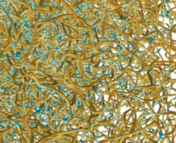Authors: Miao Li and Stephanie Tonnesen
First Author’s Institution: Center for Computational Astrophysics, Flatiron Institute
Status: Submitted to ApJ, available on ArXiv
Simulations are a powerful tool in astronomy. Processes that take billions of years in reality can be played out over a much smaller timescale on a computer. The exact time a simulation takes to run depends on a few things, mainly the size and resolution of the simulation, as well as the speed of the computer itself.
The problem
Resolution is a critical issue when it comes to any simulation; galaxy formation in particular involves both very large and very small processes. In the early years of galaxy formation simulations, researchers found that simulated galaxies weren’t accurately reproducing the observed rates of star formation. They realized that a relatively small process must be having a large effect, known as feedback. There are two main drivers of feedback: active galactic nuclei and supernovae. Each of these events take place on relatively small physical scales but can change galaxies in ways we are still uncovering.
The trick comes in simulating these small scale processes in large simulations. Instead of modeling the actual processes, rough approximations are made and inserted into the simulation. While these approximations are becoming increasingly better, they are still not ideal. The authors of today’s paper, Li and Tonnesen, wanted to investigate how the circumgalactic medium (a.k.a all the gas and dust surrounding a galaxy) could be affected by supernovae.
The process
Supernovae are the spectacular deaths of large stars. As they die, they throw out large amounts of matter at incredible speeds. Although a single star is relatively small compared to a galaxy, stars in clusters tend to die at around the same time and the collective energy released can create an outflow that pushes gas out of the galaxy.
Li and Tonnesen first simulated supernovae to understand these outflows and then inserted the results of that simulation at random into a larger simulation of a galaxy.
The product
They found that these outflows created a hot atmosphere surrounding the galaxy which, once fully formed, had fountain modes. Fountain modes are exactly what they sound like — gas closer to the galaxy gets pushed away by the supernovae winds until it gets far enough away that gravity has a stronger effect than the wind and it falls back toward the galaxy.
Figure 1: A slice through the center of the galaxy in the y-z plane, where y is the horizontal direction and z is vertical. The slices are 400 by 400 kiloparsecs. The different boxes represent number density, temperature, pressure, z-velocity, metallicity and entropy. (Source: Figure 3 in the paper)
Figure 1 shows a cross section of the simulated galaxy and the values of certain parameters. The fountain modes are best depicted in the lower left panel. The plot is a slice from the y-z plane, where z is the vertical axis. The colors represent the velocity in the z direction, red for positive and blue for negative. The mix of red and blue shows that there is not uniform motion away or toward the galaxy, but a constant motion like that of a fountain.
Much like Earth’s atmosphere, clouds can form in the galactic atmosphere of gas surrounding the simulated galaxy. As the gas condenses, it sinks back toward the galaxy. We see evidence of high-velocity clouds such as these in the Milky Way.
The prospective
These results paint a fascinating picture of a dynamic galactic atmosphere, but the paper only covered the case where the gas driven by the supernovae outflows did not have enough energy to escape the gravitational pull of the galaxy. This resulted in the gas falling back down, creating the fountains. In a future paper, the authors will explore the case where this is not always true, and gas is allowed to leave the galaxy altogether.
By fully understanding the effects supernovae can have on a single galaxy, better approximations of feedback can be implemented in even larger simulations, which can teach us even more about the universe we inhabit.




